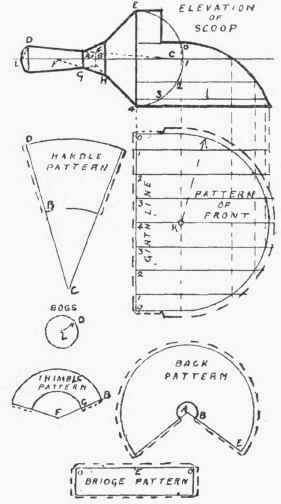Hand Scoops
Description
This section is from the book "Practical Sheet And Plate Metal Work", by Evan A. Atkins. Also available from Amazon: Practical Sheet And Plate Metal Work.
Hand Scoops
The cone surface, as we have seen, plays a most important part in building up the shapes of a multitude of articles. A simple application, and one that can be readily understood by the amateur, is in the construction of a hand scoop, as shown in Fig. 284. It will be seen that the handle, thimble, and back of scoop are formed by parts of cones of different dimensions. The patterns for the handle, thimble, and back are shown set out in Fig. 284 in the usual way; the letters on the lines of the different patterns being the same as the lines in the elevation to which the compasses have been set for the various radii.
Z
The pattern for the front part of the scoop can be obtained by treating it as a portion of a straight pipe. A semicircle is drawn on the line E 4, and the bottom half divided into three equal parts. Lines square to E 4 are run through the points until they cut the front edge of scoop. It will be observed that the top edge of scoop body cuts the semicircle at the point O. A girth line is set down for the pattern and lengths 0 to 1, 1 to 2, etc., marked along as shown. Lines are drawn through these points perpendicular to the girth line, and cut off the same length as the corresponding line in the elevation. These are shown cut off by the dotted lines, which are projected from the ends of the lines in the elevation. In practice,however, lines should be measured directly from the figure, and lengths marked off without projection. The projection method is used in the illustration to better explain how the various lines are obtained. An unbroken curve is now drawn through the points, and laps added on to the net pattern as required. When the front curve of the scoop is not required to be of any specific shape it is usually marked out on the pattern as a semicircle. Thus, in this case if centre K be chosen and half the length of the girth line taken as radius, the pattern curve will come out practically the same as that which has been obtained by the method previously explained. But in all cases where the shape is definite the first method must be pursued.

Fig 284.
The bridge pattern will be a straight strip, its length being equal to twice the length of the arc O E on the semicircle. On the patterns for the front, bridge, and back, allowances have been made for wiring, for grooving bridge to front, and for knocking up along the joint E 4. If there is to be no wiring, or if the joints are to be soldered instead of grooved, then the allowances must, of course, be somewhat different.
The radius for marking out the boss blank will be equal to the line L D in the elevation.
The handle, thimble, and back will be fastened together by firmly soldering; also the boss will be just let into the end of handle, soldered, and cleaned off. A small disc should be soldered in the back at B to block up the hole, or this can be accomplished by cutting the back pattern out as for that of a complete cone.
Continue to:


